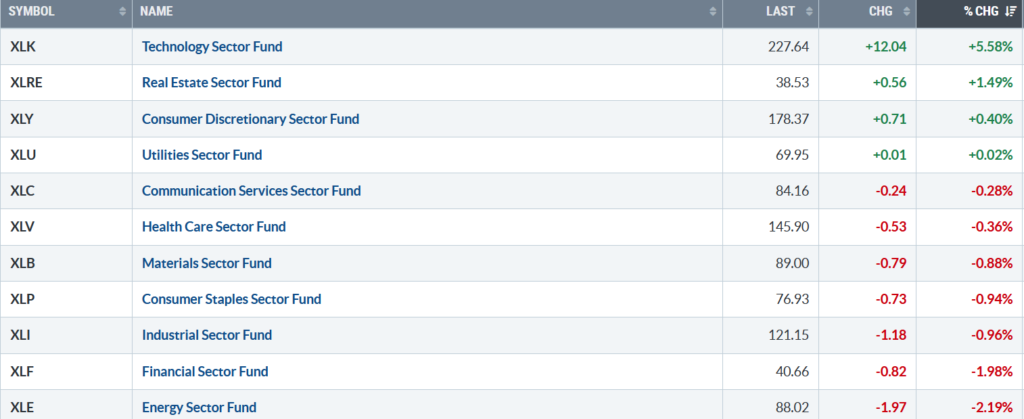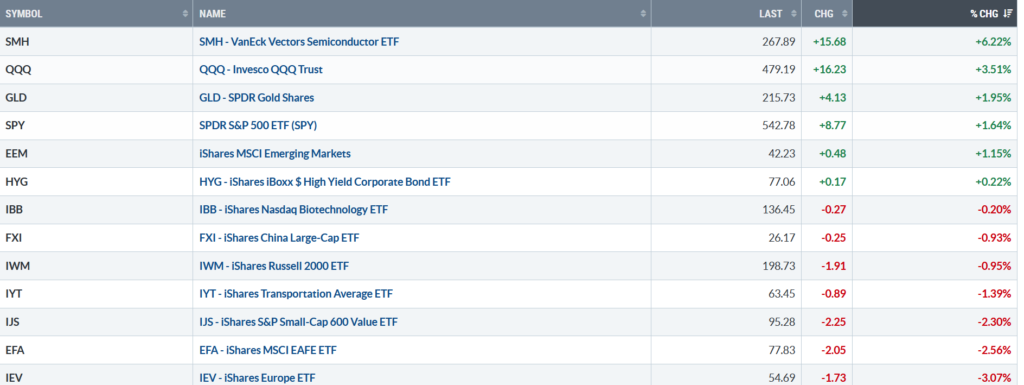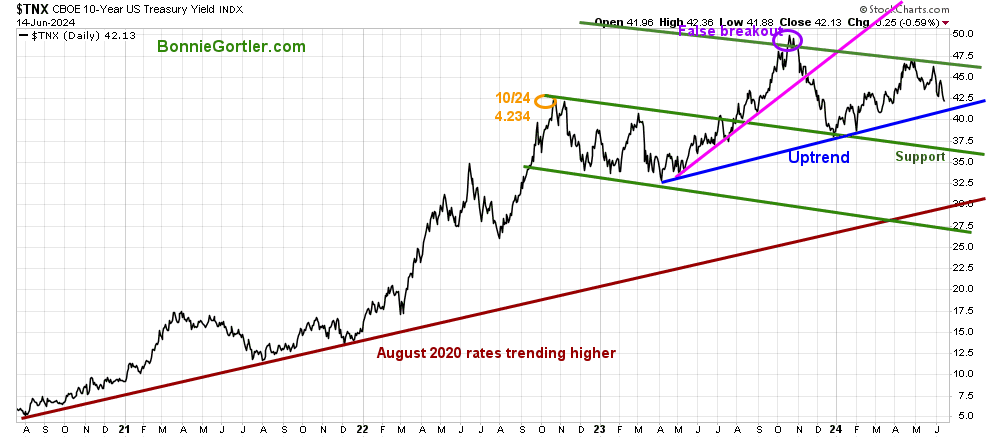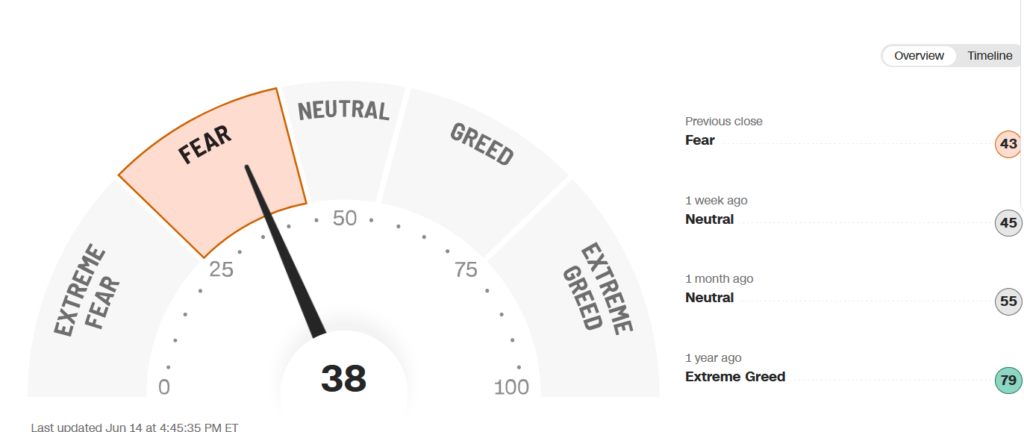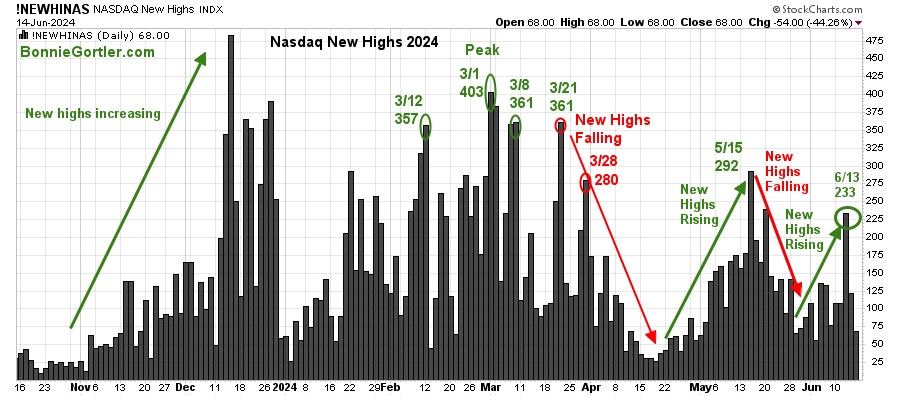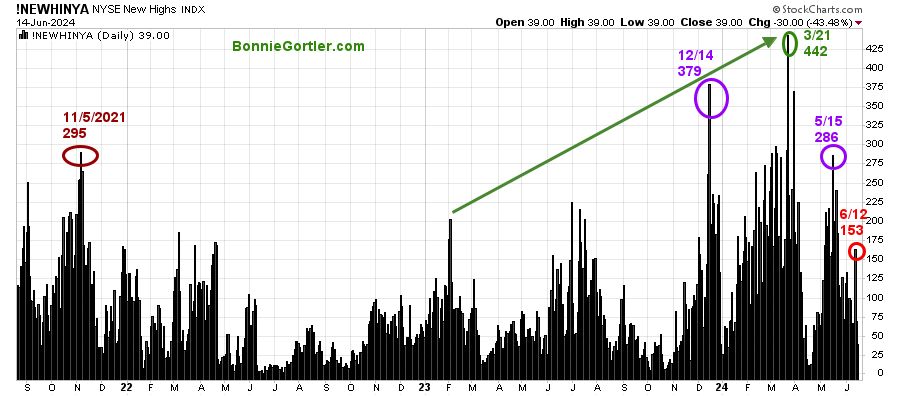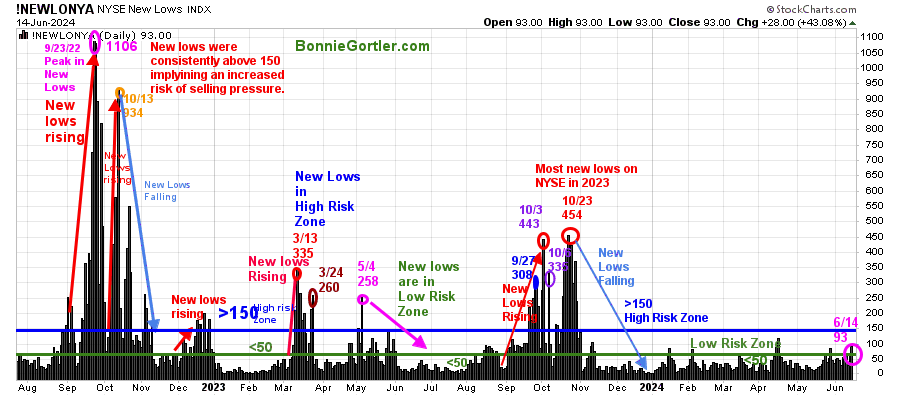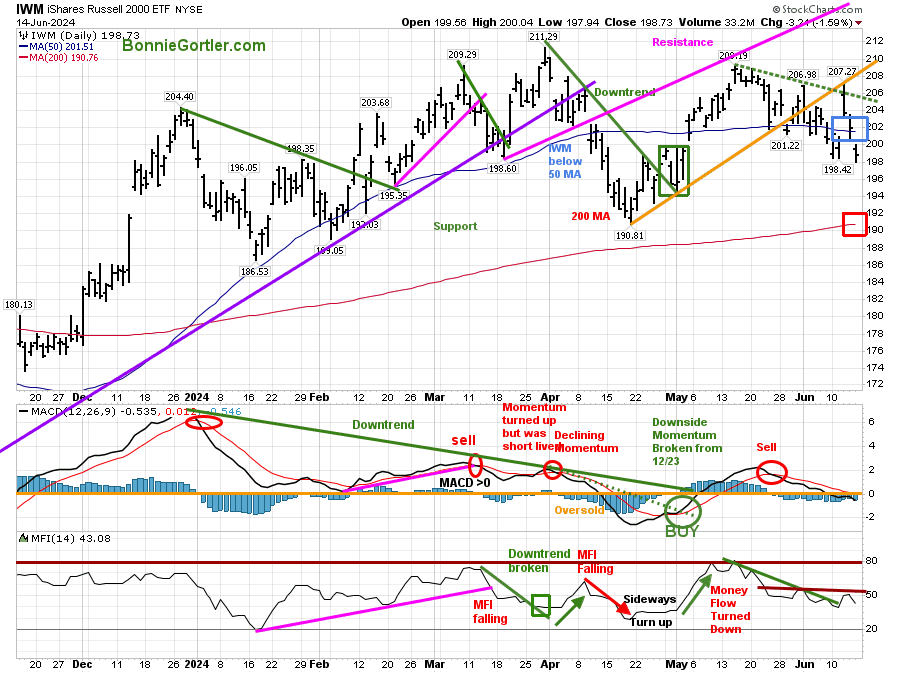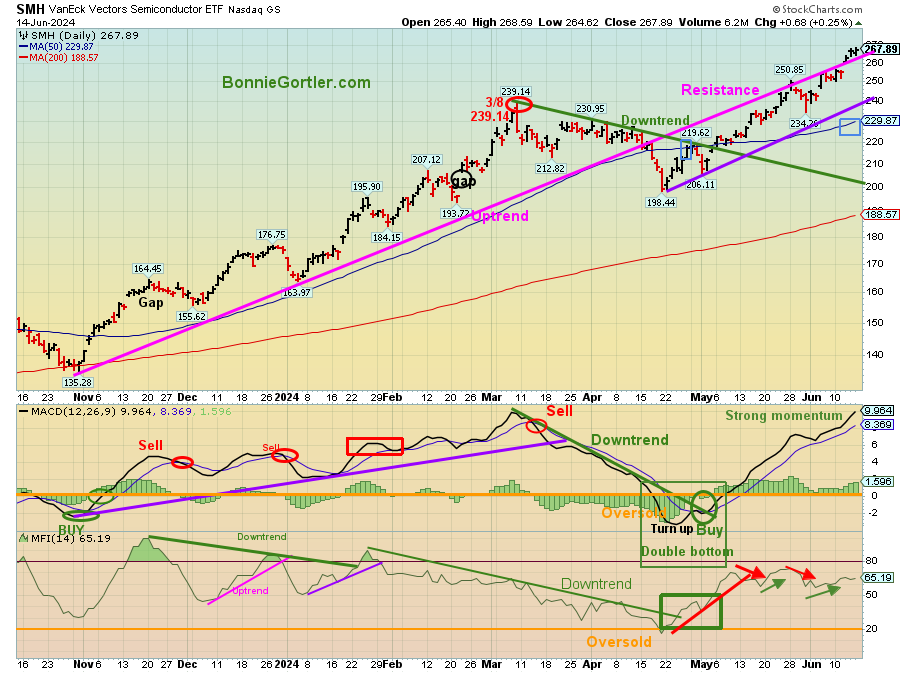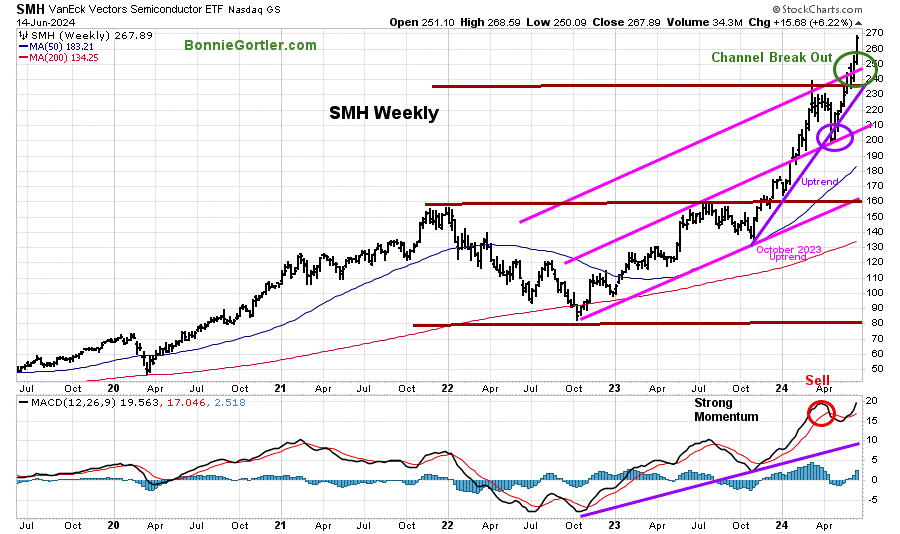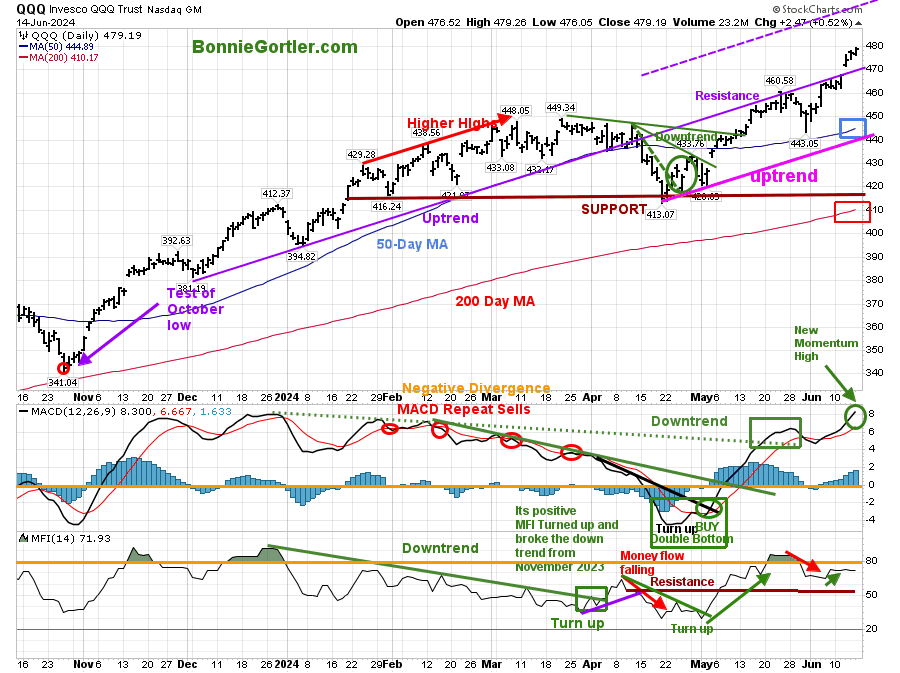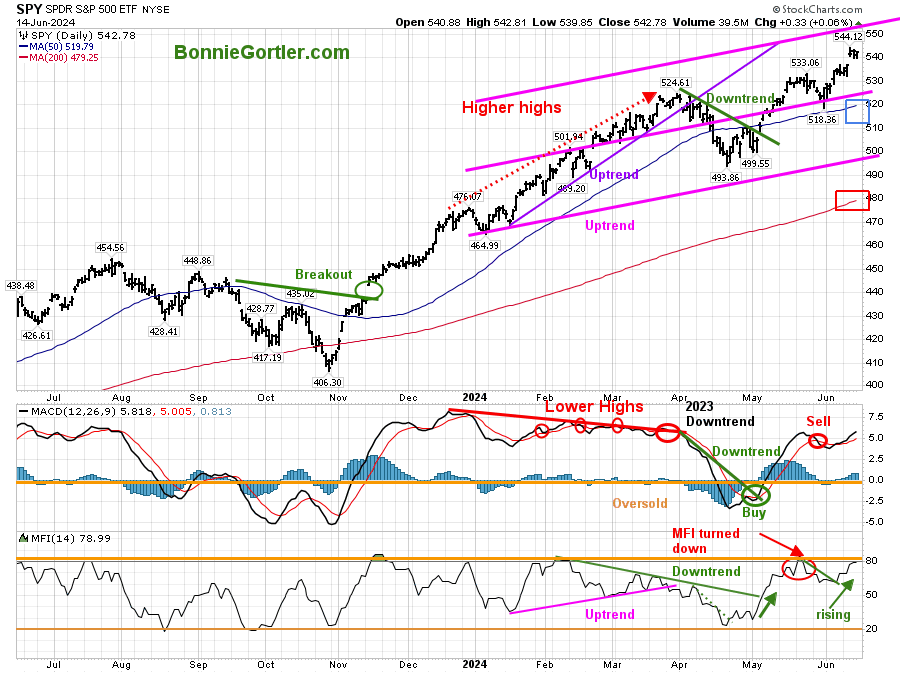Bonnie’s Market Update 6/14/24
Bonnie’s Market Update 6/14/24
New Highs in the S&P 500 and Nasdaq. However, it is concerning that only four out of the eleven S&P SPDR sectors finished higher last week. Technology (XLK) and Real Estate (XLRE) were the strongest, while Financials (XLF) and Energy (XLE) were the weakest. The SPDR S&P 500 ETF Trust (SPY) gained +1.64%.
S&P SPDR Sector ETFs Performance Summary 6/7/24-6/14/24
Source: Stockcharts.com
Figure 2: Bonnie’s ETFs Watch List Performance Summary 6/7/24-6/14/24
Source: Stockcharts.com
Semiconductors and Technology continued to lead. Gold had a solid gain. Emerging Markets led while Europe was weak. Small-cap growth, value, and Transports continued to underperform, which is concerning.
Figure 3: UST 10YR Bond Yields Daily
Source: Stockcharts.com
The 10-year U.S. Treasury fell last week, closing at 4.213% and close to breaking a key uptrend from March 2023. Yields continuing to trend down would likely be positive for U.S. Equities. On the other hand, yields reversing higher and closing above 4.75% could fuel selling pressure in U.S. Equities.
Figure 4: Fear & Greed Index
Source: CNN.com
Investor sentiment based on the Fear and Greed Index (a contrarian index) measures the market’s mood. The Fear and Greed Index shows fear with the major averages near or at all-time highs, implying higher prices.
The major market averages were mixed last week. The Dow fell -0.54%, the S&P 500 gained +1.58%, and the Nasdaq was up +3.24%, the best performer. The Russell 2000 Index continues to lag, falling -1.01%. The Valueline Arithmetic Average, which includes approximately 1700 stocks, was down by -1.42%, closing at 10041.74, yet to take out the March high of 10577.97.
Market Breadth Continues to Weaken
Weekly market breadth was negative on the New York Stock Exchange Index (NYSE) and for the Nasdaq. The NYSE had 1017 advances and 1883 declines, with 240 new highs and 158 new lows. There were 1846 advances and 2747 declines on the Nasdaq, with 315 new highs and 409 new lows.
Are you interested in learning more about investing in the stock market? Discover how to implement a powerful wealth-building mindset and simple, reliable strategies to help you grow your wealth in my eCourse Wealth Through Investing Made Simple. Learn more here.
Fewer Stocks Have Made New Highs on the Nasdaq and the NYSE
Figure 5: Nasdaq New Highs (6/14/24)
Source: Stockcharts.com
The chart above is a daily chart of the number of stocks making new 52-week highs on the Nasdaq. New highs peaked on 3/1 at 403. On March 8 and 21, New Highs were less at 361, unable to surpass the high made on 3/1. In April, the Nasdaq weakened before moving higher.
Last week, the Nasdaq made a new all-time high. However, New Highs have not confirmed the high, with only 233 stocks on 6/13 making a new 52-week high and contracting on 6/14, closing at 68.
Figure 6: Daily New York Stock Exchange (NYSE) New Highs (6/14/24)
Source: Stockcharts.com
The chart above is a daily chart of the number of stocks making new 52-week highs on the New York Stock Exchange Index (NYSE). New highs hit 442 on 3/21/24, surpassing the 12/14/23 reading of 379, the best since 6/1/21 when there were 448. However, in May and June, New Highs contracted with only 286 New Highs made on 5/15 and continue to fall, not confirming the NYSE price New High.
NYSE New Highs closed at 39 on 6/14. Watch this week if New Highs expand, reaching at least 286, better if over 442, which would be bullish for the near term, or if they remain low, a clue of short-term weakness to follow.
Are you interested in learning more about investing in the stock market? Discover how to implement a powerful wealth-building mindset and simple, reliable strategies to help you grow your wealth in my eCourse Wealth Through Investing Made Simple. Learn more here.
Figure 7: New York Stock Exchange (NYSE) New Lows
Source: Stockcharts.com
Watching New Lows on the New York Stock Exchange is a simple technical tool that helps increase awareness of the direction of an immediate trend.
For most of 2022, new lows warned of a potential sharp pullback, high volatility, and “panic selling,” closing above 150. The peak reading of New Lows in 2022 was on 9/23 at 1106, not exceeded in 2023.
In 2024, New Lows have stayed below 150, and a good part of the year below 50, a sign of a healthy market.
Last week, New Lows on the NYSE reached their highest reading since April 16 when there were 116, closing at 93 (pink circle), on the rise.
It’s time to watch New Lows closely. If new lows fall between 25 and 50, it will be positive in the short term. On the other hand, an increase above 150 would be a warning sign of a market correction.
Learn more about the significance of New Lows in my book, Journey to Wealth, published on Amazon. If you would like a preview, get a free chapter here.
Small Caps Continue to Weaken
Figure 8: Daily iShares Russell 2000 (IWM) Price (Top) and 12-26-9 MACD (Middle) and Money Flow (Bottom)
Source: Stockcharts.com
The top Chart is the daily iShares Russell 2000 Index ETF (IWM), the benchmark for small-cap stocks, with a 50-Day Moving Average (MA) (blue rectangle) and 200-Day Moving Average (MA) (red rectangle) that traders watch and use to define trends.
IWM peaked in March and fell below the 50-day MA in early April before reversing higher in May. However, IWM could not make a new high and turned down, and it remains in a downtrend (green dotted line).
IWM closed near its low for the week, at 198.73, falling -0.95%. Once again, IWM is weaker than the S&P 500, failing to generate any upside momentum. After breaking above the 50-day MA midweek, it closed below a sign of underlying weakness.
Support is at 194.00 and 191.00. Resistance is at 200.00, 206.00, and 210.50.
MACD (middle chart) remains on a sell, falling with weakening momentum.
Money flow (lower chart) broke its downtrend but quickly turned down.
The odds of IWM testing the high will increase if IWM closes for two days above the downtrend (green dotted line) and closes on 6/21 above last week’s weekly high of 207.27. On the other hand, a weekly close below 197.94 would imply more weakness in the future.
Semiconductors and Technology Continue Higher
Figure 9: Daily Semiconductors (SMH) (Top) and 12-26-9 MACD (Middle) and Money Flow (Bottom)
Source: Stockcharts.com
The top chart shows the Daily Semiconductors (SMH) ETF, concentrated mainly in US-based Mega-Cap Semiconductor companies. SMH tends to be a leading indicator for the market when investors are willing to take on increased risk, and the opposite is true when the market is falling.
The Semiconductor ETF (SMH) powered ahead above resistance (pink line), closing at 267.88, gaining +6.22%, led by NVIDIA, the top holding of almost 25%, and was up 9.10% after its 10:1 stock split.
SMH remains well above the 50-day (blue rectangle) Moving Average, a sign of underlying strength. MACD made a new momentum high, implying another rally is likely after SMH peaks. Support is 260.00, 246.00 (old resistance), 225.00, and 200.00. The upside objective of 320.00 remains (see the weekly chart below).
MACD (middle chart) remains on its buy, rising above 0, with strong momentum.
Money Flow Index (MFI), in the lower chart) has been whipsawing in May under the overbought level of 80 (red and green arrows). In June, Money Flow continued to trend higher.
Further strength in SMH is positive for the broad market.
Are you interested in learning more about the stock market? Learn how to implement a powerful wealth-building mindset and simple, reliable strategies to help you grow your wealth in my eCourse Wealth Through Investing Made Simple. Learn more here.
Figure 10: Weekly Semiconductors (SMH) (Top) and 12-26-9 MACD (Bottom)
Source: Stockcharts.com
The Semiconductors (SMH have broken out above the intermediate channel (green circle). The upside objective is 320.00. A weekly close below 225.00 would negate the upside objective and break the weekly uptrend.
MACD, a measure of momentum, remains on a sell but is rising as SMH broke out above the top channel.
If you would like to discuss charts further, email me a good time that works for you at Bonnie@BonnieGortler.com.
Are you interested in learning more about the stock market? Learn how to implement a powerful wealth-building mindset and simple, reliable strategies to help you grow your wealth in my eCourse Wealth Through Investing Made Simple. Learn more here.
Figure 11: Daily Invesco QQQ Trust (QQQ) Price (Top) and 12-26-9 MACD (Middle) and Money Flow (Bottom)
Source: Stockcharts.com
The Chart shows the daily Invesco QQQ, an exchange-traded fund based on the Nasdaq 100 Index. QQQ made a low in October 2023 (red circle), followed by an uptrend at the start of 2024. QQQ broke the 50-day MA in April 2024 but held support and started a new uptrend, which remains in effect.
Nasdaq 100 (QQQ) rose +3.51% last week, back-to-back strong weeks, closing near its high at 479.1. QQQ remains well above the 50-day MA (blue rectangle) and the 200-day MA (red rectangle). Support is at 465.00, 445.00, 440.00, and 415.00. The intermediate-term objective remains 520.00 (chart not shown). A weekly close below 465 would negate the upside objective.
The bottom chart, MACD (12, 26, 9), remains on a buy, above 0, rising sharply, a new momentum high after breaking the December downtrend (green rectangle).
Money flow (lower chart) turned up in April, breaking the downtrend. There was a brief turndown in May, and then it turned up, hitting 80 (orange line) before pulling back and moving sideways. As long as it stays above 50, I view MFI as positive.
In Sum:
QQQ has had a solid rally, from an oversold condition to a new all-time high, helped by Apple no longer lagging other Technology stocks. I would like to see QQQ remain above 465.00, implying potential further gains towards 520.00, the intermediate upside target.
Figure 12: The S&P 500 Index (SPY) Daily (Top) and 12-26-9 MACD (Middle) and Money Flow (Bottom)
Source: Stockcharts.com
The SPY April downtrend (green line) broke in early May, shifting the short-term trend up. SPY closed at 542.78, up +1.64%, remaining above the 50-day Moving Average (blue rectangle) and the 200-day Moving Average (red rectangle).
Support is at 533.00, 519.00, 499.00 and 480.00. Resistance is at 544.00, with an upside potential objective of 550.00.
MACD (middle chart) is on a sell above 0, not falling enough to get oversold below 0 to generate a fresh buy.
Money flow (bottom chart) accelerated higher after breaking the February downtrend (green line), peaked above 80 (orange circle), and fell for much of May but turned up in early June.
The trend remains up. A new upside objective will be if SPY closes for two days above 550.00. Time will tell.
Summing Up:
Nasdaq and S&P 500 hit record highs last week, but not the Dow. Although Semiconductors and Technology stocks are leading the major averages higher, market breadth is narrowing with fewer sectors participating in the rally. The weakness of the Russell 2000 Index, Transports, and Financials is disturbing and worth watching if it continues. The quarter end is only a few weeks away. The trend is your friend, and it remains up. It’s prudent to review your portfolio to ensure you have an exit plan if support levels break, momentum turns down, and the selling intensifies quickly.
Remember to manage your risk, and your wealth will grow.
Let’s talk about investing together. You are invited to schedule your Free 30-minute consultation by emailing me at Bonnie@BonnieGortler.com. I would love to schedule a call and connect with you.
Disclaimer: Although the information is made with a sincere effort for accuracy, it is not guaranteed that the information provided is a statement of fact. Nor can we guarantee the results of following any of the recommendations made herein. Readers are encouraged to meet with their own advisors to consider the suitability of investments for their own particular situations and for determination of their own risk levels. Past performance does not guarantee any future results.


